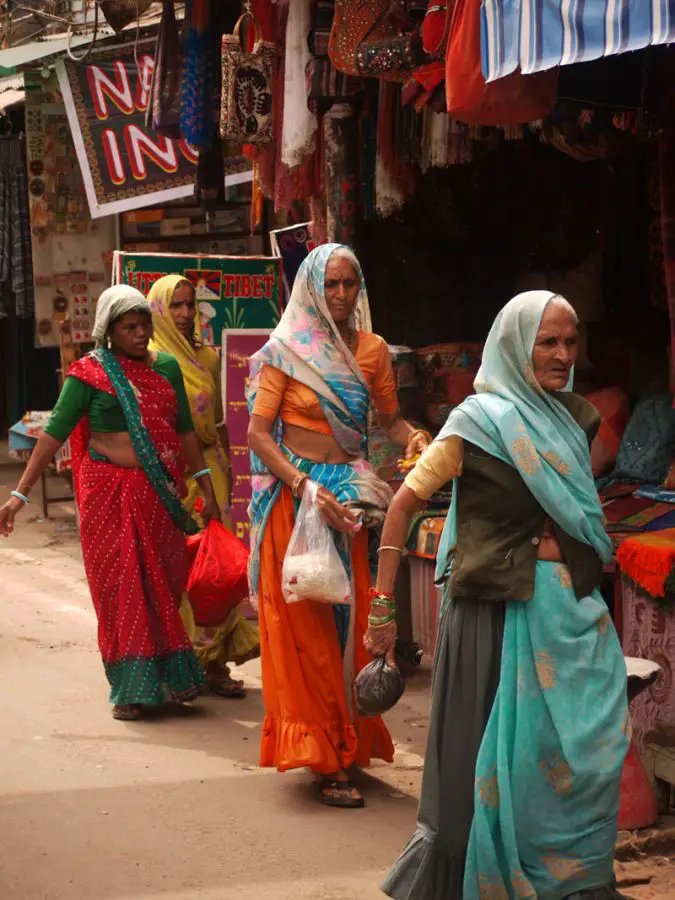A thirty minute bus ride from Ajmer is the Hindu pilgrimage town of Pushkar, a small town centered around a holy lake. The town is a hive of activity; the main bazaar is lined with food stalls, shops and sadhus all vying for the attention of the foot-traffic which marches up and down this narrow strip along the edge of the lake. Hindus are supposed to visit this holy town at least once in their lifetime and with beautiful surrounding scenery, an energetic vibe and the world’s only Brahma temple, that’s certainly not a bad thing.
Centred around the lake where the Hindu god Brahma is said to have dropped a lotus flower, the spiritual vibe around this little town is evident. Little shrines and temples, more than four hundred in all, are dotted around the busy streets and lane-ways of holy Pushkar. Surrounding the lake on every side are different ghats, each named after different Hindu gods as well as one ghat dedicated to Gandhi. There are fifty-two ghats in total where visiting pilgrims conduct pujas (prayers) seemingly non-stop. At the end of the ghats, where the steps meet the lake’s holy waters people make offerings and bathe here, dipping in and out of the water three times in the same manner as in Varanasi at the sacred Ganges River. Other residents on the ghats include excitable dogs, monkeys and thousands upon thousand of pigeons which gather to eat the seeds and grains fed to them by visitors to Pushkar.
At the western end of Pushkar is the Brahma temple, the only such temple in the world. Removing our shoes we joined the line of pilgrims and climbed the steep steps to the temple entrance. Passing through the doorway, adorned with the Hans (the goose symbol of Brahma), we stepped inside the famous temple and skipped around the long line of pilgrims waiting to give offerings and pray to their deity. Approaching the temple from the side, we were able to look inside the building, topped with a red spire to see the statue of the god within. Black in colour, the statue of Brahma has four faces and is draped with garlands of flowers left by priests and pilgrims. Engraved on the walls and on the ground inside the temple walls are dedications to the dead in Hindi, English and a bunch of other languages I didn’t recognise.
Our favourite thing about Pushkar was not the Brahma temple, the lake, the surrounding scenery or any of the other things mentioned so far, for us it was all about the rooftop restaurants. It wasn’t that these restaurants had exceptional food but it was the vantage point which they afforded us to view the busy streets below. From here, we could people watch uninterrupted. The colours from here were incredible, the contrast between the dark, muddy, dirty streets and the locals attire of bright, illuminous turbans and saris was just stunning.
Even the fruit on the stalls and the vegetables old ladies were selling from the ground of the street seemed brighter than usual and with the overcast skies they brought a new light to the hectic streets below. Cows were wandering around nonchalantly, dogs were being their usual lazy selves and the chaos below was comparable to anywhere in India we had been so far. However, with all this and more going on, it was great to take refuge on a roof and watch objectively, without being in the middle of it and see what was really happening, the interactions between the locals, the smiling faces and the visitors from near and far, for us that’s what the magic of Pushkar is all about; a chance to take a moment from the madness.

Brian is a travel writer, photographer, blogger, travel addict and adventure-junkie. Being outdoors, getting off the beaten track and outside his comfort zone is what makes him tick. Brian’s the dreamer in the relationship; when he’s not travelling, he’s dreaming about it! Keeping fit, cooking, music and red wine take up the rest of his time.
Sign up for our free travel photography Ebook "Faces of Nepal" and you'll also receive our monthly newsletter.








